Comments / Questions (21)
![]() Sarah wrote:
Sarah wrote:
Hallo, werden hier keine Randmaschen hinzugefügt? Weil sonst geht das Muster nach dem Zopf nicht mehr auf.
25.11.2025 - 12:18DROPS Design answered:
Liebe Sara, es sind hier keine zusätzliche Maschen gestrickt, dh die 30-36 Maschen je nach der Größe werden gestrickt, wie im Diagram gezeihnet. Viel Spaß beim Stricken!
26.11.2025 - 08:03
![]() Gabriele Kleinert wrote:
Gabriele Kleinert wrote:
Ich bekomme es nicht hin, das Strickstück in der Mitte zu verzopfen. Es sind zu viele Maschen zum verzapfen. Es ist zu kurz um die Nadeln von der Zopfnadel aufzunehmen. Was kann ich tun?
06.03.2025 - 11:08DROPS Design answered:
Liebe Frau Kleinert, in diesem Video zeigen wir (für ein anderes Modell), wie man so ein Stirnband verzöpfen kann; wenn es immer noch zu tricky ist, dann können Sie die Arbeit in 2 teilen, und ein paar cm über beide Hälfte stricken, und dann erst die beide Hälfte vezöpfen, wie wir das in diesem Video (für ein anderes Modell) stricken. Kann das helfen? Viel Spaß beim Stricken!
06.03.2025 - 13:45
![]() Lena Hellquist wrote:
Lena Hellquist wrote:
Finns det film på hur man gör flätan mitt fram på pannbandet? Eller en tydligare förklaring
27.01.2025 - 11:33DROPS Design answered:
Hej Lena. I denna video ser du hur man kan göra ett pannband med fläta. I mönster DROPS Children 40-28 stickas det dock inte några extra varv som i videon utan maskorna flyttas direkt. Mvh DROPS Design
28.01.2025 - 08:50
![]() Mathy wrote:
Mathy wrote:
Hei, bildet er jo ikke samme som oppskriften. Man får jo ikke de små flettene som er på bildet. Hvorfor ikke?
30.10.2024 - 23:16DROPS Design answered:
Hej Mathy, jo det gør du, du starter nederst til højre i diagrammet, vi kan forklare de første masker i de største størrelser: 1rett, 1vrang, ta 1 maske løs av pinnen som om den skulle strikkes rett, strikk 2 rett , løft den løse masken over de 2 maskerne som blev strikket rett (nu har du 4 masker på højre pind), 1 vrang, 3 rett, 1vrang osv... På næste pind strikker du vrang over vrangmaskerne og rett over rettmaskerne og imellem de 2 masker hvor du tog en ind, laver du et omslag. På 3 pind strikker du igen fra højre side i diagrammet: 1 ret, 1vrang, 1ret, 1ret(=omslaget), 1ret, 1 vrang 3 rett osv :)
31.10.2024 - 10:05
![]() Nicole wrote:
Nicole wrote:
Vielen Dank. Jetzt hat es geklappt, aber das Muster ist irgendwie verdreht. Habe die zopfmaschen in einer hinreihe abgehoben, die letzten 15 gestrickt und dann die ersten 15. jetzt ist aber quasi die Rückseite oben (vor dem Zopf die Hinreihe). Was muss ich beachten? Vielen Dank schonmal!!
15.10.2024 - 12:39DROPS Design answered:
Liebe Nicole, beachten Sie daß die letzten Maschen auch bei einer Hin-Reihe (wie die ersten Maschen) gestrickt werden, so sind Sie sicher daß die Arbeit nicht gedreht wird. Viel Spaß beim Stricken!
15.10.2024 - 16:48
![]() Nicole wrote:
Nicole wrote:
Ich habe eine Frage. Wenn ich den Zopf Stricken will komme ich dabei überhaupt nicht zurecht, weil die Maschen viel zu eng sind. Gibt es einen Tipp? Danke!
15.10.2024 - 08:49DROPS Design answered:
Liebe Nicole, wir haben keinen besonderen Tipp, versuchen Sie die Maschen genauso wie zuvor zu stricken, dh nicht zu eng aber auch nicht zu locker. Nach einpaar Reihen wird es wieder einfacher. Vielleicht können Sie mit einer Rundnadel stricken, so sind Sie veilleicht bequemer? Viel Spaß beim Stricken!
15.10.2024 - 10:35
![]() Tony Dixon wrote:
Tony Dixon wrote:
Brilliant, thank you for the explanation makes sense now. Did not help that I was working the graph the wrong way around. Just hoping I can stretch the knitting across to get the 18 stitches off the cable needle later xxxx
18.09.2024 - 15:35
![]() Tony Dixon wrote:
Tony Dixon wrote:
DROPS children 40-28 Hi. Sorry I do not understand graph. For groups of 3 stitches. Row 3 I think means … knit 2 together, yarn over needle then knit 3rd stitch ( makes 3 stitches on needle). Row 4 then says …slip 1, knit 2 (therefore using the 3 stitches) then pass the slipped stitch over which just leaves 2 stitches from the 3 on the needle. I know I am misunderstanding something but cannot figure out where I am going wrong. Please help. Thank you.
17.09.2024 - 18:04DROPS Design answered:
Hi Tony, You read the diagrams bottom up and from right to left from the right side or left to right on the wrong side. If it is the first row you are struggling on, this is: K1, P2, slip 1 stitch knit-wise, knit 2 and pass the slipped stitch over the 2 knitted stitches (1 stitch decreased which is replaced by the yarn over on row 2). Hope this helps and happy knitting!
18.09.2024 - 06:48
![]() Anita wrote:
Anita wrote:
Vad betyder när en ruta är svart på diagrammet och det står att rutan är ingen maska utan gå vidare. Vad gör jag med den maskan då?
01.09.2024 - 21:38DROPS Design answered:
Hei Anita. Det betyr at det ikke er noen maske. Om du ser på pinnen under, streken som går over 3 masker, her har du felt 1 maske og har kun 2 masker. Disse 2 maskene vises i diagrammet på pinnen over, mens den masken som er felt vises med en sort rute (det er ingen maske lengre). På 2.pinne gjøres det også kast, disse kastene blir til en maske på pinnen over, 3. pinne (3 rettmasker). mvh DROPS Design
02.09.2024 - 14:24
![]() Marlies Van Dijk wrote:
Marlies Van Dijk wrote:
Beste Drops, Is de beschrijving van de. Grote kabel middenvoor wel correct? Het gaat mij niet lukken op die manier. Ik hoor het graag, groetjes, Marlies.
07.01.2024 - 13:14DROPS Design answered:
Dag Marlies,
Ja, de beschrijving klopt. Je zet de eerste helft van de steken op een kabelnaald, dan brei je de volgende helft van de steken, waarbij de draad (die nog aan het begin van de steken die je zojuist op een kabelnaald hebt gezet) aantrekt om bij die steken te kunnen. Dan brei je de eerste helft van de steken. In plaats van een kabelnaald zou je ook een sokkenbreinaald kunnen gebruiken of de steken even op een hulpdraad zetten.
11.01.2024 - 19:01
Lavender Laces#lavenderlacesheadband |
||||||||||||||||
 |
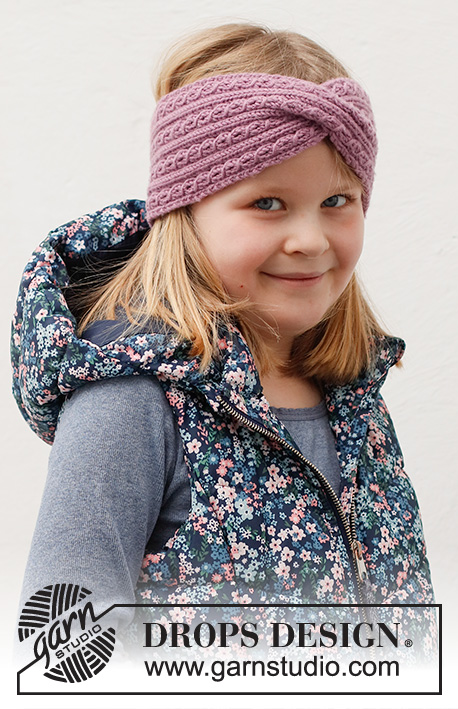 |
|||||||||||||||
Knitted head-band for children, with cable, in DROPS Merino Extra Fine. Sizes 2 – 12 years.
DROPS Children 40-28 |
||||||||||||||||
|
------------------------------------------------------- EXPLANATIONS FOR THE PATTERN: ------------------------------------------------------- RIDGE/GARTER STITCH (worked back and forth): Knit all rows. 1 ridge = knit 2 rows. PATTERN: See diagram A.1. Choose diagram for your size. ------------------------------------------------------- START THE PIECE HERE: ------------------------------------------------------- HEAD-BAND – SHORT OVERVIEW OF THE PIECE: The piece is worked back and forth from mid-back and sewn together to finish. HEAD-BAND: Cast on 30-30-36-36 stitches with needle size 4 mm and DROPS Merino Extra Fine. Work 1 RIDGE back and forth – read description above. Work diagram A.1 – choose diagram for your size. Continue pattern A.1 until the piece measures 22½-23½-24-24½ cm. REMEMBER THE KNITTING TENSION! (You have worked half the length; try the head-band on and work to desired length). Now a cable is worked mid-front as follows: Place the first 15-15-18-18 stitches on the cable needle, work the remaining 15-15-18-18 stitches. Then work the 15-15-18-18 stitches from the cable needle. Continue back and forth with A.1 as before until the piece measures 45-47-48-49 cm – the piece should be of equal length either side of the cable. Work 1 ridge over all stitches. Cast off. Sew the band together mid-back, inside the cast-on and cast-off edges. Fasten the strand. |
||||||||||||||||
Diagram explanations |
||||||||||||||||
|
||||||||||||||||
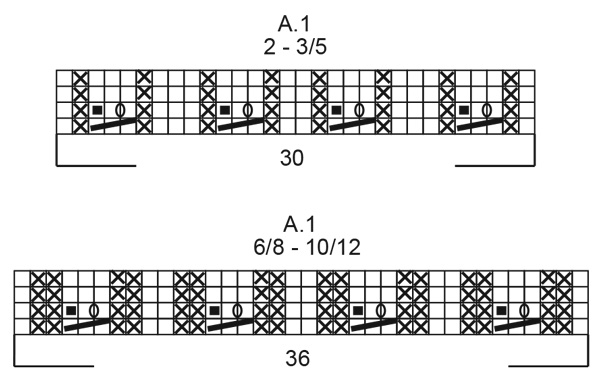 |
||||||||||||||||
Have you finished this pattern?Tag your pictures with #dropspattern #lavenderlacesheadband or submit them to the #dropsfan gallery. Do you need help with this pattern?You'll find 14 tutorial videos, a Comments/Questions area and more by visiting the pattern on garnstudio.com. © 1982-2025 DROPS Design A/S. We reserve all rights. This document, including all its sub-sections, has copyrights. Read more about what you can do with our patterns at the bottom of each pattern on our site. |
||||||||||||||||







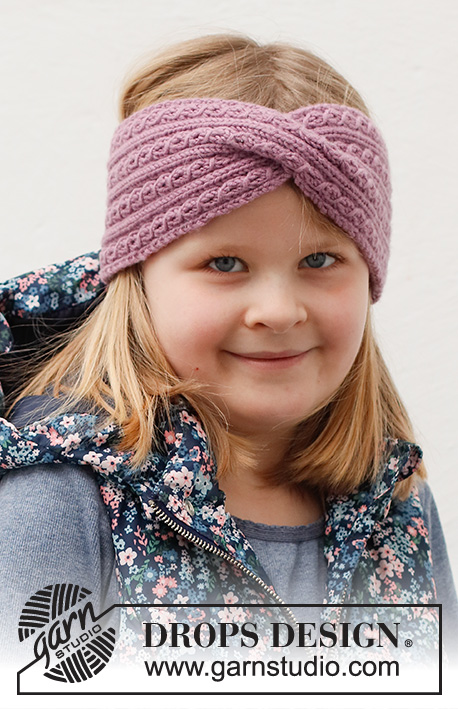
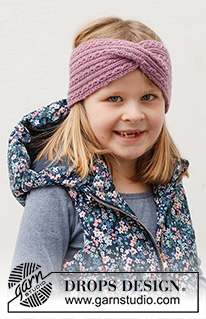
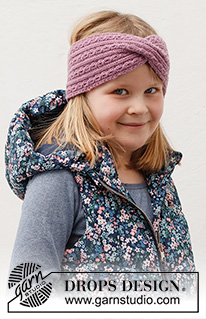
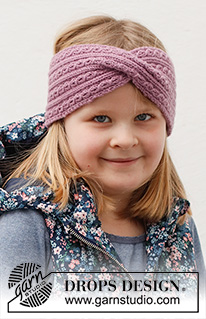





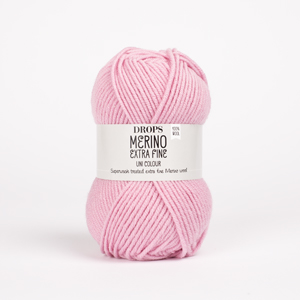
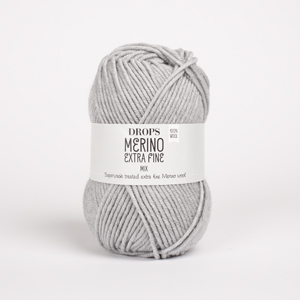


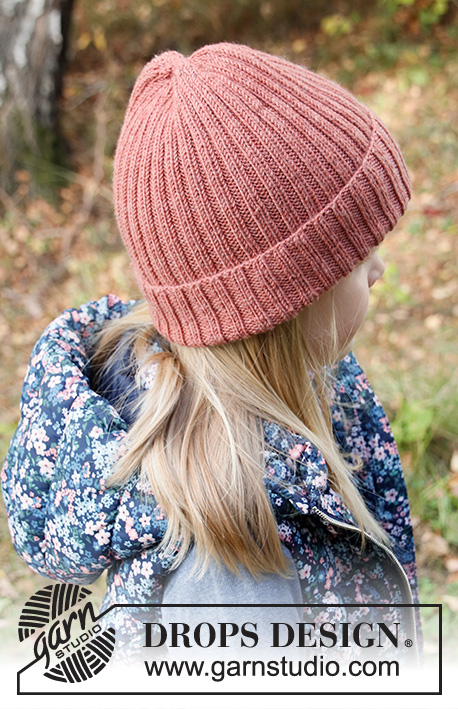

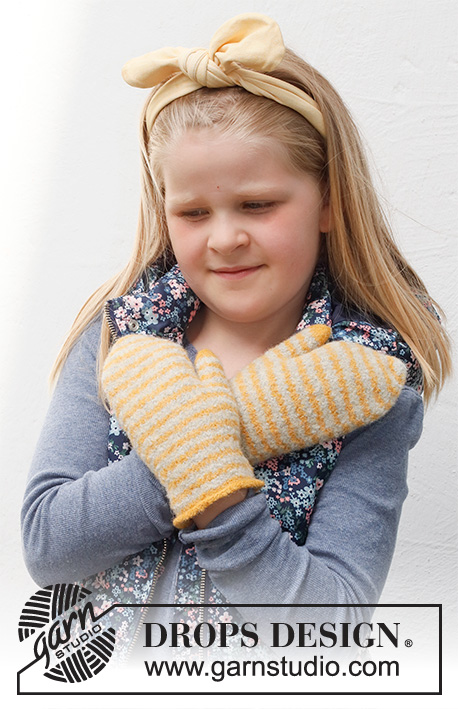


































Post a comment to pattern DROPS Children 40-28
We would love to hear what you have to say about this pattern!
If you want to leave a question, please make sure you select the correct category in the form below, to speed up the answering process. Required fields are marked *.